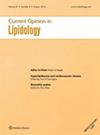Effectiveness of cascade screening for elevated lipoprotein(a), an underdiagnosed family disorder.
IF 4.6
3区 医学
Q2 BIOCHEMISTRY & MOLECULAR BIOLOGY
引用次数: 0
Abstract
PURPOSE OF REVIEW Elevated lipoprotein(a) [Lp(a)] is a prevalent, independent, genetic risk factor for cardiovascular disease. Though crucial for adequate risk assessment, detection of individuals at increased risk because of elevated Lp(a) is severely lacking in practice. In this light, several consensus statements have recommended familial cascade screening strategies to increase detection of elevated Lp(a). This review aims to synthesize findings from recent research into the effectiveness of cascade screening for elevated Lp(a). RECENT FINDINGS Cascade screening is an effective method for identifying individuals with elevated Lp(a) and is superior to opportunistic screening. Cascade screening identifies approximately one new case of elevated Lp(a) ≥ 125 nmol/L for every two first-degree relatives screened. The number needed to screen (NNS) ranged from 1.3 to 2.9, depending on Lp(a) threshold values and selected population. SUMMARY Cascade screening appears to be a promising strategy for identifying individuals with elevated Lp(a). However, several challenges persist regarding the implementation of this strategy in clinical practice. Deciding on threshold values for initiating cascade screening, considering the implications of ethnicity-related variability of Lp(a) levels, and further research into the clinical relevance of cascade screening are crucial steps. Understanding these factors will be essential for optimizing cascade screening protocols and enhancing its effectiveness in clinical practice. GRAPHICAL ABSTRACT http://links.lww.com/COL/A31.对脂蛋白(a)升高(一种诊断不足的家族性疾病)进行级联筛查的效果。
综述目的脂蛋白(a)[Lp(a)]升高是心血管疾病的一个普遍、独立的遗传风险因素。尽管脂蛋白(a)升高对充分的风险评估至关重要,但在实践中严重缺乏对因脂蛋白(a)升高而风险增加的个体的检测。有鉴于此,一些共识声明建议采用家族式级联筛查策略,以提高脂蛋白(a)升高的检出率。本综述旨在综合近期对 Lp(a) 升高级联筛查有效性的研究结果。级联筛查每筛查两名一级亲属,就能发现约一例 Lp(a) 升高≥ 125 nmol/L 的新病例。根据脂蛋白(a)阈值和所选人群的不同,需要筛查的人数(NNS)从 1.3 到 2.9 不等。然而,在临床实践中实施这一策略仍面临一些挑战。决定启动级联筛查的阈值、考虑与种族相关的脂蛋白(a)水平变化的影响以及进一步研究级联筛查的临床相关性是至关重要的步骤。了解这些因素对于优化级联筛查方案和提高其在临床实践中的有效性至关重要。Graphicraphic ABSTRACThttp://links.lww.com/COL/A31.
本文章由计算机程序翻译,如有差异,请以英文原文为准。
求助全文
约1分钟内获得全文
求助全文
来源期刊

Current opinion in lipidology
医学-内分泌学与代谢
CiteScore
6.70
自引率
4.50%
发文量
64
审稿时长
6-12 weeks
期刊介绍:
With its easy-to-digest reviews on important advances in world literature, Current Opinion in Lipidology offers expert evaluation on a wide range of topics from six key disciplines including nutrition and metabolism, genetics and molecular biology, and hyperlipidaemia and cardiovascular disease. Published bimonthly, each issue covers in detail the most pertinent advances in these fields from the previous year. This is supplemented by a section of Bimonthly Updates, which deliver an insight into new developments at the cutting edge of the disciplines covered in the journal.
 求助内容:
求助内容: 应助结果提醒方式:
应助结果提醒方式:


